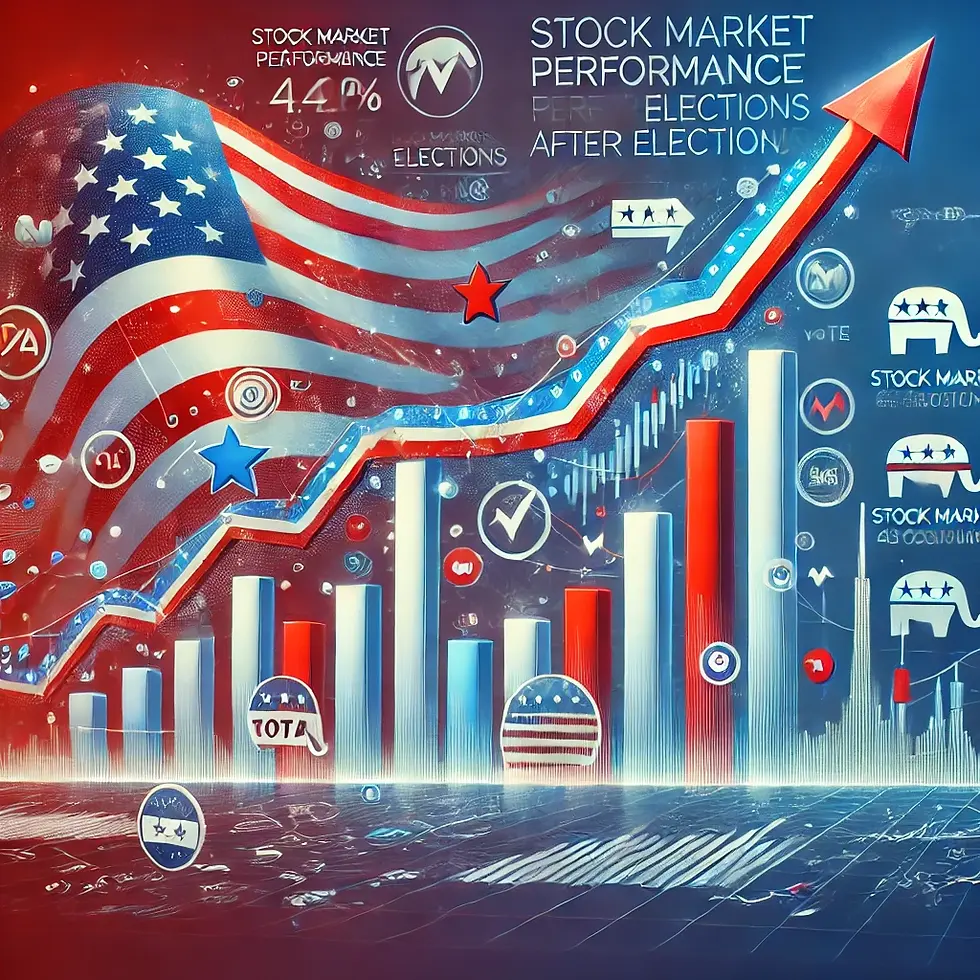
As we approach another U.S. presidential election, many investors are left wondering how the stock market will react. While markets are driven by a variety of factors, historical analysis reveals that U.S. presidential elections do have a notable impact on market performance. But how significant is that impact, and what can we expect this time around?
Historical Performance of the Stock Market After Elections
Let's take a closer look at how the market performed in the weeks surrounding the last four presidential elections:
2020 Election (Biden vs. Trump):
Week Before: Down -5.6%
Week After: Up +7.3%
2016 Election (Trump vs. Clinton):
Week Before: Down -1.9%
Week After: Up +3.8%
2012 Election (Obama vs. Romney):
Week Before: Up +0.1%
Week After: Down -2.4%
2008 Election (Obama vs. McCain):
Week Before: Up +4.6%
Week After: Down -7.9%
As you can see, the week leading up to and the week following presidential elections can be volatile. However, that doesn't always predict how the market will behave in the months ahead.
Looking beyond the immediate aftermath, historical data suggests that the stock market generally trends upwards in the month following a U.S. presidential election. Since 1960, the S&P 500 has posted gains in 12 of the last 16 election cycles, regardless of which party won the White House. Some of the most notable performances include:
2020 (Biden vs. Trump): Up ~10.9%
2016 (Trump vs. Clinton): Up ~5.6%
2008 (Obama vs. McCain): Down ~8.4%
1980 (Reagan vs. Carter): Up ~6.6%
1972 (Nixon vs. McGovern): Up ~4.4%
This upward trend is largely driven by investor confidence in the reduced uncertainty that follows an election. Markets tend to respond well when there is clear guidance on future policies, fostering a sense of stability. For example, the 2020 post-election rally reflected optimism in the transition of power and the potential for economic recovery following the COVID-19 pandemic.
However, it's important to remember that external events, such as economic crises, can still influence market behavior. For instance, the 2008 financial crisis, which overlapped with the election of Barack Obama, led to significant declines despite the election result. Similarly, the 2000 election, marred by the recount process, triggered market volatility due to the prolonged uncertainty of the election outcome.
For a more in-depth look at how election years historically affect the stock market, read our earlier analysis here: Election Year Stock Market History: What Past Trends Reveal About 2024.
Current Market Outlook Leading Into 2024 Elections
As we approach the next U.S. election, the stock market is showing some signs of a possible downturn in the weeks leading up to Election Day. Our projected cycles indicate market weakness leading into the election, followed by a stronger rally afterward, aligning with the typical post-election upward trend we've seen in past cycles.
For instance, our Visualizer cycles are predicting that the current intermediate cycle uptrend is nearing a peak, which we expect to form by the end of this week. While this suggests some short-term gains, it also signals that a potential decline may follow, particularly if external events create more uncertainty.
Given these projections, it's crucial for investors to be cautious and protect gains by setting tight stop-losses. We may see some volatility in the immediate aftermath of the election, particularly if results are contested or if there is uncertainty about the future direction of fiscal and monetary policies. However, based on historical performance, we anticipate a positive market response once the results are clear and policy directions are more certain.
People Also Ask About Stock Market Performance After Elections
How do elections affect the stock market?
Elections can create short-term volatility in the stock market due to uncertainty about the future direction of economic policies. However, stock market performance after elections generally stabilizes, and often trends upward once the election is over and policies become clearer.
Is the stock market typically bullish after elections?
Yes, historical data shows that the stock market tends to rise after elections, particularly when there is political continuity or when investors feel confident in the stability of future policies.
Which sectors perform well after elections?
Sectors such as technology, financials, and healthcare often perform well after elections, depending on the policies of the incoming administration. For example, technology stocks saw significant gains following the 2016 election.
Resolution to the Problem
If you're looking to capitalize on market movements during election years, it's essential to adopt a proactive trading strategy. By aligning your trades with cycle analysis and historical trends, you can minimize risks and position yourself for potential gains. Relying on time-tested strategies and staying informed about key market-moving events can help you navigate election-driven volatility with confidence.
At Market Turning Points, we specialize in providing timely market insights and strategies that align with key cyclical movements. Our Forecast charts give you the tools to anticipate market peaks and troughs, helping you stay one step ahead of the market.
Conclusion: What Can We Learn From Stock Market Performance After Elections?
In conclusion, while elections can bring short-term volatility, the stock market has historically shown resilience and a tendency to rally in the months following Election Day. As we approach the upcoming U.S. election, staying informed about market cycles and protecting gains through tight stop-losses is key. By understanding how elections influence market performance, investors can better position themselves to navigate potential uncertainties and capitalize on opportunities.
To learn more about how our cycle-based approach can help you make informed trading decisions, join Market Turning Points today!
Join Market Turning Points
Stay ahead of market trends and improve your trading performance with Market Turning Points. By subscribing, you gain access to daily market commentary, forecast charts, AI-driven price projections, a weekly webinar, private VIP Facebook Group, and more. Our proprietary Visualizer tool and strategic insights will help you confidently navigate market cycles and seize opportunities as they arise. Join our growing community of traders who rely on our expertise to predict tomorrow’s market today.